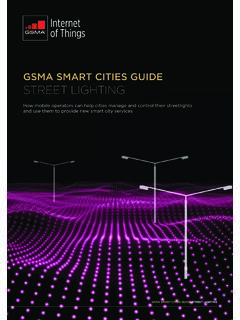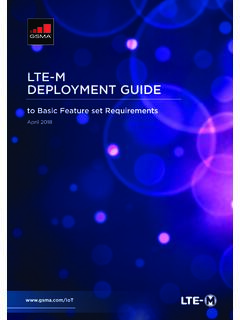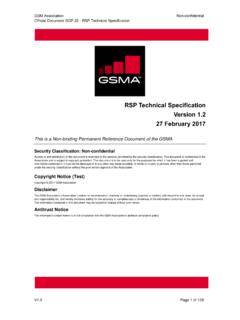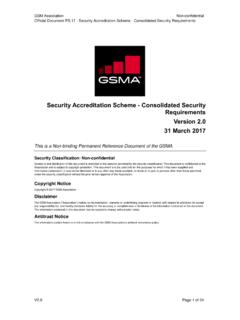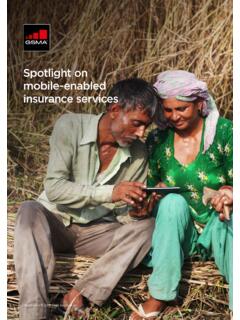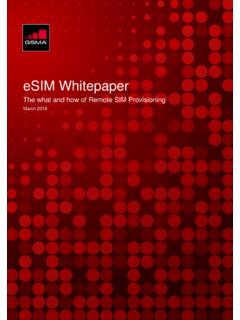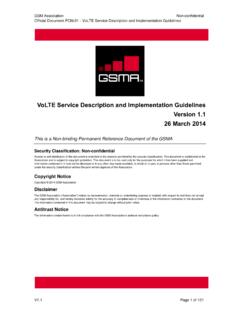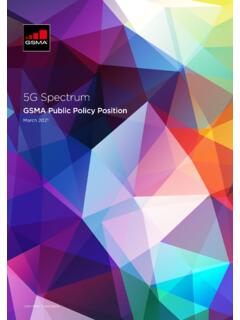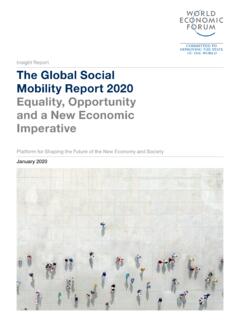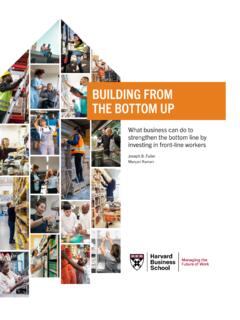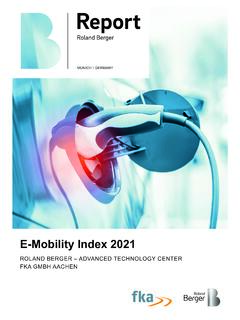Transcription of The Mobile Economy
1 Copyright 2021 GSM AssociationTheMobileEconomy 2021 GSMA Intelligence is the definitive source of global Mobile operator data, analysis and forecasts, and publisher of authoritative industry reports and research. Our data covers every operator group, network and MVNO in every country worldwide from Afghanistan to Zimbabwe. It is the most accurate and complete set of industry metrics available, comprising tens of millions of individual data points, updated daily. GSMA Intelligence is relied on by leading operators, vendors, regulators, financial institutions and third-party industry players, to support strategic decision-making and long-term investment planning. The data is used as an industry reference point and is frequently cited by the media and by the industry itself. Our team of analysts and experts produce regular thought-leading research reports across a range of industry GSMA represents the interests of Mobile operators worldwide, uniting more than 750 operators with almost 400 companies in the broader Mobile ecosystem, including handset and device makers, software companies, equipment providers and internet companies, as well as organisations in adjacent industry sectors.
2 The GSMA also produces the industry-leading MWC events held annually in Barcelona, Los Angeles and Shanghai, as well as the Mobile 360 Series of regional more information, please visit the GSMA corporate website at the GSMA on Twitter: @GSMAC ontentsExecutive summary2 The Mobile market in growth continues everywhere, but at varying nears peak as 5G adoption go weighs on financials, but recovery will be swift19 Key trends shaping the Mobile : commercialisation gathers telco of the future: operators ramp up eSIM service : digital transformation of the enterprise accelerates32 Mobile contributing to economic growth and addressing social challenges s contribution to economic enhancing digital and financial delivering social impact49 Policies for shaping the post-pandemic digital investment and spectrum policy meeting future connectivity demand601234 The Mobile Economy 2021 Executive summary2 Executive summaryCovid-19 emphasises the importance of connectivity to society s wellbeing The Covid-19 pandemic has had a profound impact on the health and livelihoods of individuals and communities around the world.
3 In these trying times, connectivity has emerged as a lifeline for society by enabling many social and economic activities to continue amid unprecedented social and travel restrictions, supporting new ways for enterprises to operate safely and facilitating effective response measures from government and other stakeholders. Mobile has been particularly instrumental during this period, keeping people connected and underpinning new services in response to the pandemic. Around the world, the exceptional scale and utility of Mobile networks and services have: enabled people to work and learn remotely, stay in touch with loved ones, and perform many other everyday activities online supported innovative health solutions, such as remote patient monitoring and contact tracing, to control the spread of the virus provided a platform for people to access digital financial services, given efforts to reduce the reliance on cash facilitated the safe and efficient distribution of social welfare to vulnerable people generated valuable insights on mobility patterns from anonymised and aggregated Mobile big data to inform government response measures at various stages of the the world emerges from the pandemic, connectivity will be crucial to helping economies recover and become more resilient to future shocks.
4 This will come in the form of timely access to life-saving information and services for otherwise excluded populations, enhanced productivity and efficiency through 5G- and IoT-enabled digital transformation of industries, and new opportunities and market access for people and enterprises. With the digital Economy set to be at the heart of a post-Covid-19 world, the urgency to bring unconnected communities online has never been Mobile Economy 2021 Executive summary35G momentum builds, but 4G still has room to growThe launch of commercial 5G services in Latin America and Sub-Saharan Africa over the last year means that the technology is now available in every region of the world. The pandemic has had little impact on 5G momentum; in some instances, it has even resulted in operators speeding up their network rollouts, with governments and operators looking to boost capacity at a time of increased demand.
5 By the end of 2025, 5G will account for just over a fifth of total Mobile connections and more than two in five people around the world will live within reach of a 5G leading 5G markets, such as China, South Korea and the US, 4G has peaked and, in some cases, begun to decline. In many other countries, particularly in developing regions, 4G still has significant headroom for growth. Much of the growth in 4G will come from existing 4G infrastructure, as 5G will account for 80% of total capex over the next five years. Globally, 4G adoption will peak at just under 60% by 2023 as 5G begins to gain traction in new growth is slowing, but Mobile s contribution to the global Economy remains significantBy the end of 2020, billion people subscribed to Mobile services, representing 67% of the global population. Adding new subscribers is increasingly difficult, as markets are becoming saturated and the economics of reaching rural populations are becoming more difficult to justify in a challenging financial climate for Mobile operators.
6 That said, there will be nearly half a billion new subscribers by 2025, taking the total number of subscribers to billion (70% of the global population). Large under-penetrated markets in Asia and Sub-Saharan Africa will account for the majority of new 2020, Mobile technologies and services generated $ trillion of economic value added ( of GDP) globally. This figure will grow by $480 billion by 2025 to nearly $5 trillion as countries increasingly benefit from the improvements in productivity and efficiency brought about by the increased take-up of Mobile services. 5G is expected to benefit all economic sectors of the global Economy during this period, with services and manufacturing seeing the most Mobile Economy 2021 Executive summary4 The Mobile industry continues to lead in efforts to tackle climate issues In April 2021, the Mobile sector was credited by the United Nations (UN) for achieving a critical breakthrough towards its mission of combatting climate change.
7 Being the first major sector to achieve the rigorous criteria set by the UN s Race to Zero campaign demonstrates the commitment and leadership of Mobile operators in the push to meet the goals of the Paris Agreement. This comes at a time when political and economic leaders are giving renewed impetus to delivering a zero-carbon world. Today, 50% of operators by connections and 65% by revenue have committed to science-based targets (SBTs) on the reduction of carbon Mobile Economy 2021 Executive summary5 Policies to shape the post-pandemic digital economyMobile technology will play a key role as governments look to reinvigorate their economies and build a better, more inclusive society. Now is the right moment for governments to reassess the business and regulatory environment for Mobile services in order to accelerate investment and innovation.
8 To realise this, governments need to: direct stimulus funds towards digital development support financial sustainability of the Mobile sector remove barriers to network deployment ensure fair competition harmonise EMF limits establish balanced policies for personal , positive decisions that help drive the availability of spectrum are crucial for governments and regulators that want to realise high-performance networks and services, particularly for 5G. Successful 5G networks and services depend on a significant amount of new harmonised Mobile spectrum. Initially, regulators should aim to make available 80 100 MHz of contiguous spectrum per operator in prime 5G mid-bands ( GHz) and around 800 MHz per operator in high bands (mmWave spectrum). Lower bands (600 and 700 MHz) are also required to provide wide-area capacity and ensure that 5G reaches spectrum availability, the cost of spectrum also has a major impact.
9 Governments and regulators should assign 5G spectrum to support their digital connectivity goals rather than as a means of maximising state revenues. Effective spectrum pricing policies are vital to support better quality and more affordable 5G services. High reserve prices, artificially limited spectrum supply (including set-asides) and poor auction design can all have a negative impact ( slower Mobile broadband and supressed network investments).Penetration ratePercentage of populationPenetration ratePercentage of 67% 70%UNIQUE Mobile oftotal connections (excluding licensedcellular IoT) 21%INTERNET OF THINGSM obile ecosystem contribution to public funding Connections(before regulatory and spectrum fees)$410bnPUBLIC FUNDINGJobs directly supported by the Mobile ecosystem+13m 12mEMPLOYMENT 56% 57%jobs supportedindirectlyGlobal Market $ INDUSTRY CONTRIBUTION TO GDP $ INTERNET USERS 51% 60%2025 Operator capex of $900 billion forthe period 2021 2025 (80% on 5G)$ $ REVENUES AND INVESTMENT 20202025 Total revenues2020-2025 CAGR: : (excluding licensed cellular IoT) CONNECTIONSP enetration ratePercentage of population 103% 107%20252020-2025 CAGR.
10 Of connections(excluding licensed cellular IoT)SMARTPHONES2020 68% 81%2025 Percentage of connections(excluding licensedcellular IoT)Penetration ratePercentage of populationPenetration ratePercentage of 67% 70%UNIQUE Mobile oftotal connections (excluding licensedcellular IoT) 21%INTERNET OF THINGSM obile ecosystem contribution to public funding Connections(before regulatory and spectrum fees)$410bnPUBLIC FUNDINGJobs directly supported by the Mobile ecosystem+13m 12mEMPLOYMENT 56% 57%jobs supportedindirectlyGlobal Market $ INDUSTRY CONTRIBUTION TO GDP $ INTERNET USERS 51% 60%2025 Operator capex of $900 billion forthe period 2021 2025 (80% on 5G)$ $ REVENUES AND INVESTMENT 20202025 Total revenues2020-2025 CAGR: : (excluding licensed cellular IoT) CONNECTIONSP enetration ratePercentage of population 103% 107%20252020-2025 CAGR: of connections(excluding licensed cellular IoT)SMARTPHONES2020 68% 81%2025 Percentage of connections(excluding licensedcellular IoT)Executive summary8 TECHNOLOGY MIX*4G5G2G3 GSMARTPHONE ADOPTIONSUBSCRIBER PENETRATION81%82%81%69%2020202519%39%42% 5%16%65%14%CISTECHNOLOGY MIX*4G5G2G3 GSMARTPHONE ADOPTIONSUBSCRIBER PENETRATION83%87%86%78%2020202510%20%69% 1%5%59%35%1%EuropeTECHNOLOGY MIX*4G5G2G3 GSMARTPHONE ADOPTIONSUBSCRIBER PENETRATION89%85%83%73%202020254%2%82%52 %48%12%Greater ChinaTECHNOLOGY MIX*4G5G2G3 GSMARTPHONE ADOPTIONSUBSCRIBER PENETRATION83%62%58%68% 2025 2020 2025 2020 2025 20202020202523%20%56%6%11%71%12%1%Asia Pacific 2025 2020 2025 2020 2025 2020 2025 2020 2025 2020 Note.

